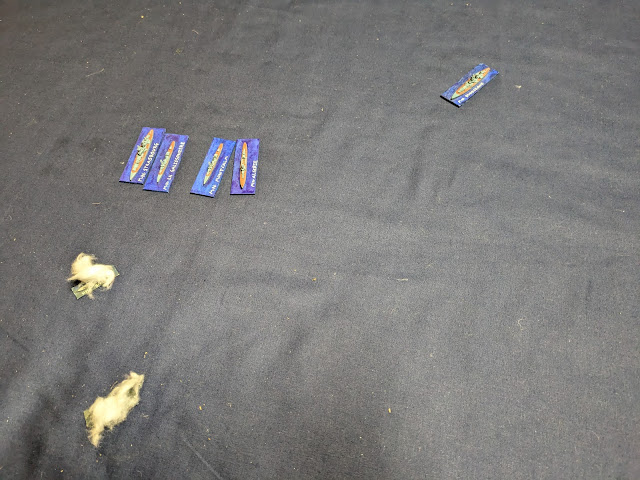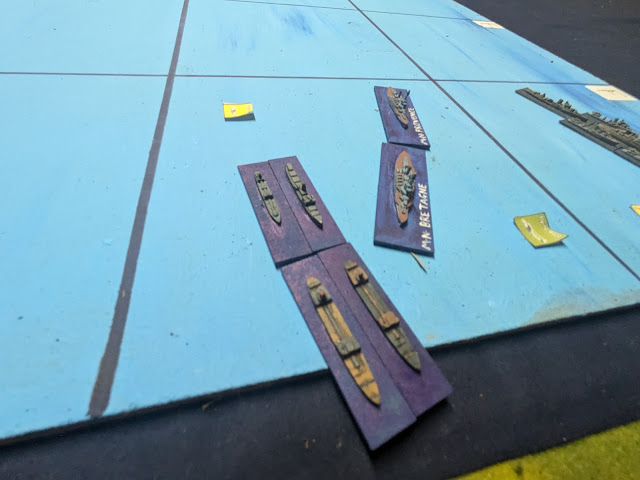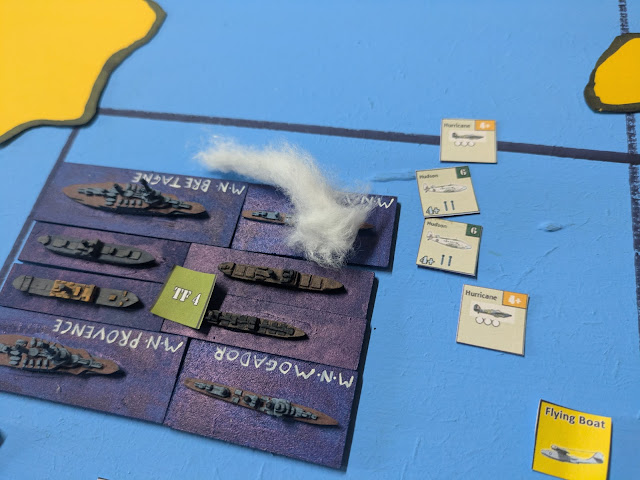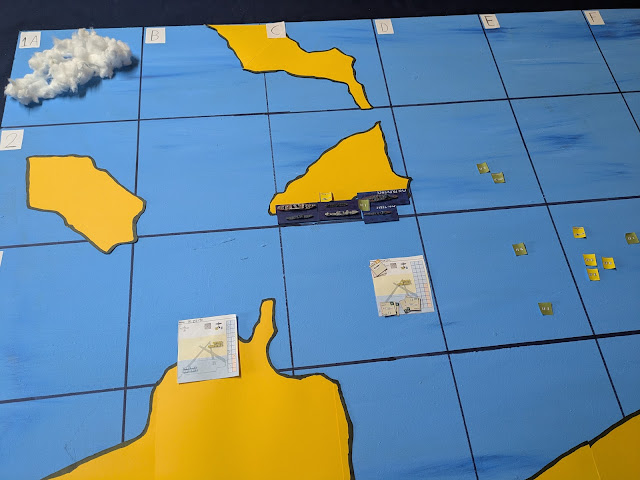Straights of Sicily - February 1941
Setup: The Vichy French have a vital convoy they must escort from the safety of Algeria to their far flung colony of Syria, through the contested waters of the central Mediterranean. In this campaign we are using an adaptation of the Nimitz 'straights of Sicily' scenario. The French have a small airstrip at Bizerte whilst the British have a more substantial airfield on Malta. British naval assets are assumed to be arriving from the direction of Alexandria. 
Day 1 Morning: The British win the initiative and launch an overwhelming first strike. Eight flights of Hudson bombers take off from Malta and proceed to destroy the entirety of the French bomber wing whilst they are still on the runways at Bizerte.*
Day 1 Afternoon: Four more flights of Hudson spot the lone French cruiser Gloire scouting the Tunisian coast. She is badly damaged in their attack run. 
Day 2 Morning: The British send out a squadron of Hudson's to finish off Gloire but her crew fight bravely to the end, downing half of their foes before she slips beneath the waves.

With a heavy escort of Hurricanes, the British bombers make a lucky guess and find the French convoy! Their initial attack run is badly disrupted by flak and two flights of Hudson's are destroyed for the loss of only one French destroyer.
Day 2 Afternoon: The British fleet makes all speed for Malta, but their air force squander the afternoon and fail to find the convoy again.

Day 2 Night: The French convoy skirts the Sicilian coast, where a British submarine lying in wait torpedo's and sinks one of the large cargo ships.
Day 3 Morning: As the dawn breaks the RAF come out in full force to assail the convoy. Two more large cargo ships are sunk and the old dreadnought Provence is hit by a bomb, disabling one of her main turrets.
Day 3 Afternoon: The British aircraft once again rearm, whilst their fleet is chased back to the east by multiple large radar blips that could be another French force of unknown composition.
Day 3 Night: The convoy moves north east into the Ionian sea.

Day 4: The massed Hudson bombers terrorise the convoy, sinking five more large cargo ships, and badly damaging the heavy cruisers Colbert and Foch.
Day 4 Afternoon: The aerial assault continues. The last of the large cargo ships are destroyed alongside the remaining three escorting destroyers. All that remains of the convoy are the smaller cargo ships, the dreadnoughts and two crippled heavy cruisers.

Day 5 Morning: The Malta based bombers sally out to attack the French close escort. Colbert is reduced to a hulk and scuttled, whilst the dreadnought Provence is crippled.
Day 5 Afternoon: The British fleet remains shadowing the convoy within launch range, but are startled when a French taskforce emerges out of the storms to the north! Quickly identifying the modern battlecruisers Dunkerque and Strasbourg, the British realise they are outclassed and attempt to flee.
Battle of the Ionian
Deployment: The British fleet is divided into a vanguard made up of the heavy cruisers Cumberland, London and Norfolk with eight destroyers, and an escort for the carrier Eagle consisting of the light cruisers Ajax and Fiji with nine destroyers. The French have split into two double columns. On the portside they have the two battlecruisers, the heavy cruiser Algerie, and two destroyers. To starboard they have two light cruiser La Galissonniere and Montcalm with three destroyers.
Turn 1: All hell breaks loose as most of the British fleet turn hard to starboard and attempt to escape, whilst some of the destroyers steam ahead to launch torpedo's. Both sides suffer damage from gunnery with two French and one British destroyer lost. One of Dunkerque's salvo's sails straight through Norfolk's citadel, and she is engulfed in a mighty explosion as her magazine ignites. The overwhelming British torpedo barrage is largely a failure against the nimble French fleet, but Dunkerque is hit to stern suffering damage to her rudder and reducing her speed.
Turn 2: Eagle and the cruisers make their escape. Another French destroyer is sunk by torpedo fire, but as they turn to escape the British lose two more of their own. **
Turn 3: The French battlecruisers circle round and together with the rest of the taskforce finish off two more crippled British destroyers.
Day 5 Afternoon: With the French in close pursuit, Eagle launches two of her Albacore bombers, which succeed in knocking out a destroyer.
The Hudson's on Malta swoop in on the French. The flak barrage downs two flights, but the remainder press home their attack, sinking a destroyer and scoring another hit on Dunkerque.
Battle of the Ionian: The pursuing French briefly close within range, but they are warded off by the destroyer screen.
Day 5 Night: The convoy and the French close escort disappear into the emerging stormfront. The British cruisers accompanied by half their destroyers wait till nightfall then slip past the pursuing French and double back to towards the convoy. Eagle and its escorting destroyers head west towards Malta, but they fail to shake off the French taskforce.
Battle of the Ionian: The fast battlecruisers and contre-torpilleurs close once more with the British fleet. This time they sink two more destroyers, but fail to find Eagle in the dark. Lying in ambush, a British submarine manages to hit Dunkerque again with its torpedo spread, leaving her badly flooded and perilously close to sinking.

Day 6 Morning: Storm clouds gather around Malta, grounding its bombers but providing shelter for Eagle. The French battlecruisers break off their pursuit and head east towards the convoy, whilst the British cruisers fearful of the old French dreadnoughts retreat timidly to the north.
Day 6 Afternoon: Well rested after their forced inaction, the Hudson's come roaring in for another attack. The heavy cruiser Foch is sunk and the Dreadnought Bretagne is crippled for the loss of four aircraft.

*We like Nimitz a lot, but like most rule sets they are not perfect for our taste. The Hudson's in particular in this game seemed overpowered, and in general the effectiveness of destroying aircraft on the ground overstated. For our next campaign we will house rule to amend this.
** I really admire the ambition to keep a naval game playable on a 6*4 table, but here was an example where the rules created a distortion which impacted on our fun. Ships in Nimitz can disengage if their are no enemies within 12" or if they are moving fast. So the cruisers could get away right under the nose of the French battlecruisers, whilst Eagle could have been prevented from escaping if the French moved slowly instead of fast to block their exit points by getting within 12"!





















Comments
Post a Comment